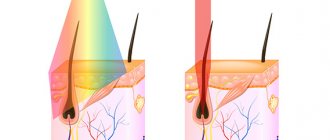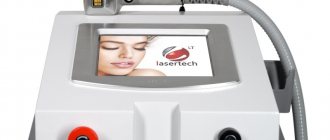Hair removal using laser hair removal
Laser hair removal is an advanced method of removing unnecessary hair, replacing razors, creams and wax. Its popularity is due to its painlessness and high effectiveness. Laser hair removal has become cheaper and more widespread, thanks to which more and more modern women prefer this method. The pain of this procedure is much lower than that of electrolysis, but complete hair removal will require more procedures.
The laser hair removal method uses a beam of light of a specific wavelength, frequency and pulse width to remove hair. This beam, depending on the type of laser, can affect different depths where the hair follicle is located. The melanin in the follicle is destroyed under the influence of the laser, as are the vessels that nourish the hair, so that some time after depilation it falls out, and the rest of the hairs in this follicle will never grow. This is why laser hair removal is called permanent hair removal.
Electrolysis is a method of hair removal
Electrolysis is a method of applying electric current to hair follicles, which destroys them and prevents the regrowth of new hair. The procedure is carried out over a long period of time in several stages, after which the skin in the selected area is exposed forever. If the client does not have allergies or other contraindications, then there are no negative consequences or scars as a result of electrolysis. Since the electrolysis method requires good knowledge of human health and the technique of using special equipment, such a service can only be provided by a licensed cosmetologist. Before making an appointment, make sure that there is no individual intolerance to the procedure.
Principle of electrolysis
Electrical hair removal is carried out using a special device - a point pen with a needle at the end or electric tweezers. A charge is formed in the tip, affecting the deep parts of the hair follicle, warming occurs, after which the bag is destroyed and loses its supply. Hair no longer grows at the treated point.
Electrolysis is carried out on short hairs 4-6 mm long. The master quickly inserts a needle near the root, and then removes the dead shoots with tweezers. Typically, a couple of weeks before the procedure, the hair in the area of interest is shaved off and given the opportunity to grow back. If the hair is too long, it will be difficult for the hairdresser to get to the roots, and short hair will be difficult to pluck.
Types of electrolysis
The types of this technique differ in the types of electrodes used during the procedure.
Needle. When removing hair, special needle electrodes are used. Their thickness should not exceed 0.1 mm. These needles are made from different materials and come in different lengths and shapes.
Tweezers. In this method, the main thing is that each hair is captured by an electrode, similar to tweezers, and a current is passed through it. The advantage of this method is that there is practically no pain, but you will have to tinker with each hair longer. Therefore, this type is usually used only in areas with minimal vegetation.
Is it possible to combine laser and electrolysis?
Laser hair removal has a negative effect on moles and is therefore carried out only in areas where there is no large accumulation. If moles are localized at points on the body in those places that will be treated, this is not a contraindication to the procedure, but in this case the moles should be carefully “camouflaged” from the laser beam. To do this, the specialist conducting the hair removal session treats the mole with a special white felt-tip pen or applies zinc paste to it. As a result, the laser beam does not affect the melanin pigment. If moles are not covered during the procedure, there is a risk of burns.
If most procedures are done with a laser, and in places where there is a cluster of moles this procedure cannot be used, then electrolysis can be used in this area.
At what age can electrolysis be performed?
It is recommended to seek help from a needle with current only when the endocrine system is already well developed. This is usually after 18 years of age. But if the child began to develop a little earlier, then it is quite possible to remove hair as needed even before the age of 18.
Electrolysis – description of the technique, effect, contraindications
Electrolysis is a way to get rid of excess hair on different parts of the body. The technique was invented in the late 1870s by an ophthalmologist who was looking for ways to remove ingrown eyelashes from patients. After some time, electroepilation found application in cosmetology, where it has been successfully used for decades.
The electrolysis method is based on the ability of a weak electric current to destroy tissue, in particular hair follicles. Irreversible necrosis resulting from leaching or coagulation of the hair follicle guarantees 100% permanent hair removal. The device used during the procedure has several operating modes. The specialist carries out individual adjustments before each session. As a result, the device delivers shocks of optimal frequency and strength.
Types of electrolysis
can be classified depending on the type of electrode used by the cosmetologist:
- Tweezers - in this case, the hair shaft is captured by a bifurcated electrode, which looks like small tweezers. The current reaches the follicle along the hair shaft, creating heat that completely destroys the hair root.
- Needling is the classic and most common method, which involves inserting a very thin needle made of a medical alloy, or other material coated with gold or titanium, into each hair follicle. The needle as an electrode transmits an electrical discharge that creates heat or provokes a chemical reaction that destroys the root. The needles are disposable and sterile. Unlike the tweezer method (about 2 minutes to process each hair), the needle method takes less time (about 2-60 seconds to process each hair).
At the same time, needle electrolysis is also divided into several types:
- Thermolysis (exposure to alternating current) - this is the method used in most cosmetology clinics. The method is that the hair root is destroyed under short-term (2 seconds) exposure to high temperature. The disadvantage of this method is that the procedure is quite painful. If electrolysis is performed by a cosmetologist with insufficient qualifications and/or experience, there is a risk of tissue burns.
- Electrolysis (direct current) - during the treatment, the follicles are destroyed due to a chemical reaction that converts the sodium ions generated around the needle into alkali. Destroying one hair follicle takes from 10 seconds to a minute. The advantage of the method is that it causes less pain and discomfort.
- Blend is a combination of thermolysis and electrolysis. Processing one hair lasts approximately 5-10 seconds. The severity of pain is moderate.
- Flash is a new generation of thermolysis. The main difference is that the current comes only from the tip of the needle, and does not pass along its entire length. Thanks to this, the procedure is not as painful as in the case of thermolysis.
To completely eliminate 100% of unwanted hair, you will need from 2 to 10 sessions.
There are several reasons for this:
- During the process of electrolysis, the cosmetologist destroys the follicles of only those hairs that have already appeared on the surface of the skin. That is, those that are in the growth stage. But those hairs that are in the sleeping stage will also need to be removed. This can be done only when they enter the active growth phase, which will happen in about 1-2 months.
- A few weeks after electrolysis, “spare” previously generally inactive follicles, which are located next to the destroyed follicles, are activated. Once hairs grow from these follicles, they can be detected and destroyed using electrolysis.
- The number of sessions required to get rid of unwanted vegetation varies individually. And it depends on the physiological characteristics of the client, the treatment area, and the density of hair growth. On average, the legs, thighs and bikini area may require 8 to 10 visits to the esthetician. To correct your eyebrows, you will need 2-3 sessions. To cleanse the skin above the upper lip and other areas of the face, you need to undergo 4 to 6 procedures.
Do I need to prepare for electrolysis? In fact, no. Simply taking a shower is enough to keep the skin in the treatment area clean. The length of the hairs can be from 3 to 10 millimeters. If the hair shafts are longer or shorter, it is difficult for the specialist to access the follicle. Accordingly, the duration and cost of the procedure increase.
Contraindications to the procedure:
- Diseases of the skin in the treatment area.
- Infectious and inflammatory diseases.
- Psychical deviations.
- Epilepsy.
- Cardiovascular pathologies.
- Intrauterine device, pregnancy, lactation (in women).
- Systemic diseases, for example, diabetes.
- Malignant and benign tumors in the body.
- Individual sensitivity to metals and alloys from which needles for electrolysis are made.
How does the electrolysis procedure work (for example, needle):
- The cosmetologist makes sure that the client has no contraindications to hair removal in this way.
- The skin in the treatment area is cleaned and disinfected.
- If the client has a low pain threshold or increased sensitivity, the cosmetologist will apply an anesthetic cream to the skin. In case of severe pain, a specialist can give an injection of Lidocaine or Ultracaine.
- Using a special device with a very thin needle at the end, the specialist processes each hair, applying current to the follicle and destroying it.
- At the end of the procedure, a soothing cream is applied to the skin.
Advantages
- This is the only method available today
, allowing you to eliminate hairs once and for all on almost any part of the body. But you need to keep in mind that the process of getting rid of unwanted vegetation can take 10-12 months or even more. But in the end you will get completely smooth skin for the rest of your life. This is confirmed by the results of clinical studies and the conclusion of the American FDA Association, which controls the field of medicine.
- There are a choice of types of electrolysis. The tweezers technique is painless.
- The color of the hairs, their thickness and length, and the color of the client’s skin do not matter. Electrolysis is a universal method.
Flaws
- Duration of the procedure
. The cosmetologist processes each hair separately. Therefore, in 60 minutes of work, the most qualified and experienced specialist cannot treat an area larger than 10 cm x 10 cm. - Since the process of destruction of hair follicles is quite slow, the specialist spends a lot of time, which means that electrolysis is expensive. On average, one hour of electrolysis costs the client 3000-4500 rubles.
- Most clinics use painful
methods of electrolysis, which makes the technique difficult to apply on sensitive areas of the body - face, armpits, bikini area.
- There is a risk of getting burns
and damage the lymph nodes located close to the surface of the skin. This is the second reason why needle electrolysis is not recommended for removing excess hair on the face and in the intimate area, in the armpits.
- If thermolysis is used
, additional risks arise. Due to the difficulty in processing large, twisted bulbs, hair may continue to grow. Complications may also occur - pustules, scars, areas of irritation and inflammation on the skin.
- Electrolysis is not used to remove hair from the nose and ears.
- There are many contraindications to electrolysis.
- Long recovery period
after each procedure – about 7 days. At this time, the skin may be swollen, reddened, and crusts may appear on it that cannot be removed. For a week after electrolysis, you must follow the cosmetologist's recommendations for skin care and avoid visiting the pool, beach, sauna, or bathhouse.
- If it is necessary to eliminate vegetation in the bikini area, on the legs, in the armpits, the first sessions of electrolysis should begin immediately after the end of summer. First, it will take time to wait until a maximum of hairs have erupted; they also need to be grown to the optimal length. By around the beginning of next summer, the client can expect that 80-90% of the hairs will be removed.
Conclusion – who is suitable for electrolysis?
Electrolysis is suitable for both women and men who are willing to spend 1-2 years to get rid of unwanted hair forever (if we are talking about eyebrow and facial hair, it will take much less time). It should also be taken into account that a person who wants to use this technique must be prepared to endure severe discomfort. And have considerable financial resources at your disposal.
Types of lasers for hair removal
In laser hair removal, the professionalism of the specialist is not as important as in electrolysis, but the choice of laser is very important .
The laser is diode, alexandrite and neodymium.
The diode laser for hair removal is more popular and effective than its predecessors; it is better absorbed by the high molecular weight pigment - melanin, without damaging the skin, blood vessels and nerve endings. The laser acts on the hair follicle, eliminating it, and the hair falls out and stops growing in the treated area. Laser flashes affect both small and large areas of skin. To protect the skin from overheating and reduce minimal pain, cosmetologists use cooling attachments, which are additionally placed on the device.
The Alexandrite laser almost instantly destroys hair follicles by exposing them to light rays. Such radiation is characterized by an extremely high temperature, but the patient does not experience discomfort during treatment, since the heat only affects the hair, without touching the skin at all.
The neodymium laser used for hair removal penetrates 4-8 mm into the skin tissue, allowing it to reach the hair follicle itself. This laser radiation is practically not absorbed by melanin, so this procedure can be carried out regardless of the client’s skin phototype (hair removal using this equipment is equally effective for both light and deeply tanned skin).
The choice of one method or another depends both on the opinion of the specialist and on the wishes of the patient himself. To avoid mistakes, you need to know the main features of the devices and understand their differences:
- The diode laser can be used on both light and dark skin because it has the same effect on the surface regardless of the amount of melanin. But this only works on dark hair.
- Not only can the Alexandrite laser beam be used on all skin types, but it is also effective at removing light frizz and light colored hair.
- The diode beam effectively copes with its task on pre-shaved hair. The second type of hair removal does not require such preparation.
Advantages and disadvantages of laser hair removal
Like any other method, laser hair removal has its pros and cons. The benefits include:
- getting rid of unwanted vegetation for a long period of time (several years) and even forever;
- the possibility of infection is excluded and the risk of scarring is minimal;
- there is practically no pain. Only sometimes patients note a slight burning sensation and discomfort, but this is largely determined by individual sensitivity;
- safety of the method. The laser beam acts exclusively on the hair without affecting the surrounding tissue. The epidermis does not contain enough melanin to overheat.
Of the minuses:
- high price . This disadvantage is quite relative, considering the effect of the procedure
- not all types of devices are suitable for light hair and dark skin
- the need to conduct several courses with large intervals between them
- presence of contraindications to the use of laser hair removal
- sometimes adverse reactions are possible in the form of burns, pigmentation, and allergic manifestations. In many ways, their appearance depends on how laser hair removal is done correctly, whether the technology is violated, whether contraindications were taken into account, and skin type when choosing a laser
Advantages and disadvantages of electrolysis
As for electrolysis, its advantages include:
- versatility - suitable for all hair types and all skin types
- greater effectiveness compared to other types of hair removal
- possibility of hair removal in any area
Disadvantages of this procedure:
- long preparation - it is necessary to abandon the epilator, wax and other methods of hair removal in advance in order to restore hair follicles
- pain (higher than laser hair removal)
- traumatic - the procedure injures the skin and there is a possibility that traces will remain from this
- high price (if you pay for the services of a good master)
- duration – sessions last a very long time (up to 4 hours depending on the zone)
- many sessions are required (usually more than the master initially promises)
Procedure requirements
Laser and photoepilation also differ in the requirements for the procedures. What should you know here?
- Neither type of hair removal is performed on gray hair - it does not contain pigment that will absorb radiation. To do this, it is better to use Qool hair removal or Elos hair removal.
- Photoepilation is suitable for dark hair; for light hair, this procedure is ineffective - it will weaken and become thinner, but no more. Laser hair removal also shows the greatest effect on dark hair, but neodymium laser hair removal can also cope with light hair.
- The best results after photoepilation are observed in people with fair skin. But light skin and dark hair in one set are not always found, and the risk of burns to light skin is much higher. Laser hair removal is, in principle, suitable for any skin. True, some limitations must be taken into account here. It is better not to use a ruby laser on tanned or simply very dark skin, but alexandrite, neodymium and diode lasers are suitable even for lightly tanned skin.
- Photoepilation is recommended for clients for whom laser procedures and electrolysis are contraindicated. Laser hair removal is recommended for those who cannot tolerate other methods for various reasons.
- The hair length for photoepilation should be 1 mm, for laser procedures - up to 1-2 mm.
- Both procedures can cause complications such as burns and hyperpigmentation.
On what parts of the body are these types of hair removal allowed?
Photoepilation is suitable for all parts of the body, but is used to a limited extent on the face - the working tip of the equipment is simply too large, and it is inconvenient for them to work on the face. Laser hair removal is also performed on all parts of the body, but due to its targeted action, it is most often used to remove hair from areas on the face. Both types of procedures are not suitable for treating the eyebrow area, since the patient’s eyes must be covered with dark glasses while the technician is working.
Safety of laser and electrolysis procedures
When developing the devices, the hair structure, which cannot be called simple, was taken into account. To compare laser and electrolysis, it is necessary to take into account the safety of their use.
For electrolysis:
- the skills of the cosmetologist are important (the needle is directed point by end to each light bulb - this requires skills to avoid scars)
- the session lasts longer, which guarantees accuracy of execution;
- the electric current acts only on the hairline, other tissues are not damaged;
- After the procedure, ingrown hairs do not appear.
For laser hair removal:
- the laser beam does not affect internal organs;
- the quality of the procedure depends on the content of melanin pigment, the highest amount in representatives of dark hair;
- Certain requirements for tanning have been established; if not met, dark spots appear on the skin;
- During the session, the skin does not heat up and is not damaged;
- The method does not cause cancer.
Is laser radiation safe?
Completely: light waves cannot penetrate the body deeper than the subcutaneous tissue and, therefore, do not affect the internal organs. The upper layers of the skin are not damaged if the type of installation is chosen correctly.
How many laser hair removal procedures are needed to remove hair forever?
The duration of the laser technique depends on the thickness of the hairline. This is why, in some cases, removing unwanted hair in beauty salons can take 2-3 hours.
In one irradiation session, no more than 30% of hairs can be eliminated (even taking into account the bulbs that are in sleep mode).
After the first laser treatment, approximately half of the visible hair is removed. Removal of the residue can be determined 14 days from the date of the procedure. However, if after 21 days there is no visible result, then you should doubt the qualifications of the specialist and write a complaint.
strongly not recommended to treat problem areas earlier than the time prescribed by the specialist , as this will reduce the effectiveness.
After the third procedure, the growth of “dormant” hair follicles is activated, since hair removal slows down this process. It is strictly forbidden to stop the procedure at this time, since in this case all financial resources will be wasted. After the fifth session, more than 85% of unwanted hair may fall out. As for subsequent procedures, they remove more than 90% of the follicles , and leaving the skin completely smooth is only possible if the human body cannot quickly regenerate the follicles.
How many procedures are required for electrolysis?
If a woman has hormonal problems, then without solving them it will be impossible to achieve smooth and silky skin. Any problems with the endocrine system must be resolved in advance. In the absence of health problems, it will take about six months to completely get rid of hair. During the course, it is not advisable to use other methods of removing body hair.
It should be understood that there is a lot of hair on the human body and not all of it is in the growth phase. To completely get rid of it, you need to find the cause of the growth.
According to reviews, the effectiveness of electrolysis is comparable to laser hair removal. For a relatively small fee, you can remove hair from any part of the body. But not every woman can withstand this procedure. Many women are hesitant to go for this type of hair removal because of the possibility of scars.
What to pay attention to in the salon?
Before you go to a beauty salon for photo or laser hair removal, pay attention to reviews about this establishment, and when visiting the salon, to the following points:
- For cleanliness in the salon itself and in the master’s workplace;
- Availability of working equipment. For example, photoepilation machines initially have a permissible number of flashes, and if the equipment is clearly old, then the lamps in it are unlikely to be in good condition. The result of the procedure directly depends on the condition of the lamps. Otherwise, if the device is old, you will overpay for additional procedures.
- The presence of a qualified master who has been trained and received permission to carry out this type of hair removal. This is important for both photoepilation and laser procedures. The effect of the latter depends on the experience of the master.
What should the master ask you if you come to him for procedures? Here are the main points:
- It must determine your skin phonotype, otherwise you may get burns due to incorrect equipment settings;
- He should ask about the presence of diseases and problems that are considered contraindications. It is best to first undergo examination by an endocrinologist;
- Immediately before photo or laser hair removal you should be offered protective glasses. Even if you come for hair removal of your legs or bikini area! Glasses will protect your eyes, otherwise you risk damaging your vision.
- The specialist should tell you about the restrictions after hair removal (for some time after the procedures it is better not to sunbathe either in the sun or in a solarium), and also give advice on skin care.
What is more effective – laser hair removal or photoepilation? As a result, let’s try to summarize all of the above:
- Photoepilation is ideal for people with dark hair on light skin; laser hair removal can be performed on slightly tanned skin.
- Laser hair removal is most often performed on the face and chest; photoepilation on the face is problematic.
- The contraindications and complications for the procedures are the same - there is no difference here.
- Photoepilation has a shorter session duration than a laser procedure, but the sessions themselves will require more to achieve the result.
- The cost of the procedures is approximately the same, but after a detailed comparison, photoepilation still costs a little more.
- The effect is better with laser hair removal, hair growth is reduced by up to 80%, with photoepilation it is lower - up to 70%.
Which method should you choose? Rely on these criteria, and also don’t forget to ask for reviews from your friends. I think that everyone will find a suitable procedure for themselves. And if you have already found it, we are waiting for your feedback in the comments!
We are waiting for you in the city center on Vasilievsky Island, a stone's throw from the Vasileostrovskaya metro station!
Based on materials from the site Prosto-Maria.ru
How and with what to remove regrown hair between sessions?
The first thing to remember is to try to damage your hair follicles as little as possible between laser hair removal treatments. Ideally, it is better not to touch the hair in this area while waiting for a new session.
However, if you still need to remove unwanted hair, it is best to use a regular razor. Yes, it is believed that after such shaving the hair will begin to grow thicker, faster and coarser, but even if the hair begins to grow faster, shaving does not affect the hair follicles themselves and does not change their number in any way, which means they will not thicken.
In addition, to remove hair without affecting the roots, you can use a depilatory cream - the chemicals in the cream destroy the hair shaft, but do not affect the hair follicle. In this case, the cream acts in the same way as a razor, but does not cut the hair, but dissolves it. However, you need to choose a cream that itself does not irritate or dry out the skin. It is best to check in advance whether there is an allergic reaction to the cream by applying a small amount of cream to the crease of the elbow, waiting 5-10 minutes and checking the next day.
But plucking or removing hair with an electric epilator, wax or sugar is strictly prohibited. This method pulls hair from the roots, violating the integrity of the skin, leaving microtraumas and damaging the hair follicle itself.
No hair removal method involving hair follicles is suitable between laser hair removal! One of the unpleasant consequences is that the bulb will remain on the skin, and the surface of the skin will be damaged by micro-impacts, and it will be impossible to conduct a new hair removal session - the laser will not “see” the damaged bulbs.
Contraindications for laser hair removal
People with various chronic diseases are not recommended to use hardware procedures; hair removal is no exception, but in addition to chronic diseases, there are still many contraindications to laser hair removal. It is not recommended for:
- pregnancy, as well as lactation;
- diabetes mellitus;
- cardiovascular diseases;
- varicose veins in areas affected by laser;
- malignant neoplasms;
- viral diseases expressed in acute form.
Contraindications to electrolysis
- cardiovascular diseases, in particular previous heart attack, stroke;
- skin inflammation;
- endocrine diseases;
- tumors of any kind;
- pregnancy, breastfeeding;
- epilepsy and all kinds of mental pathologies;
- metal intolerance;
- varicose veins (in this case, you need to use a different method to remove hair from your legs);
- You should not do the procedure during menstruation.
Features of the procedures
Preparing girls for a visit to an aesthetic beauty clinic includes a consultation with a dermatologist. The doctor examines the skin, determines its phototype and makes recommendations for attending light hair removal sessions and determines the duration of the course. The specialist warns patients about precautions during hair removal procedures.
During the month before laser or photoepilation, body hair removal is allowed exclusively with a razor. Two weeks before aesthetic manipulation, you should avoid visiting a solarium, using self-tanning, or staying in the active sun.
After an hair removal session, girls should avoid visiting baths and saunas. In the interval between procedures, you should not sunbathe in the sun or in a solarium. In the summer, it is necessary to use sunscreen and exclude long walks from your schedule to reduce the impact of solar radiation and ultraviolet radiation on the skin. Failure to follow these principles may result in unwanted pigmentation in areas affected by laser or light beams.
Painful sensations during procedures
After familiarizing yourself with the specifics of the procedures, let's talk about pain during the procedure. The intensity of pain depends mainly on the pain threshold, the quality and “progressiveness” of the equipment.
Of course, the pain of a laser procedure is much lower than that of electrolysis , but complete hair removal will require more procedures.
The latest hair removal methods reduce pain to a minimum. But if you do not follow certain rules, then all the specialist’s efforts will be wasted. Here are the steps to take to reduce pain during laser hair removal:
- A month before laser hair removal, avoid sunbathing and solariums. When you go outside, apply sunscreen to your body to minimize exposure to UV radiation.
- 2-3 days before hair removal, shave the “working area” with a razor so that the hair grows to the desired length (3-4 mm). Avoid other hair removal methods that violate the integrity of the hair follicle (waxing, sugaring, electrolysis, etc.).
- If surgery is performed on the face, do not wear makeup , otherwise burns and other side effects may occur.
- Stop taking medications one week before your procedure. If this is not possible, please inform the specialist who will perform the hair removal.
- When planning to epilate a bikini or deep bikini, wear white underwear so that the beam is absorbed only by the hair. Schedule hair removal a few days after your period ends, as your pain threshold is currently at its highest.
Which procedure is more profitable: laser or electrolysis?
Electrolysis is a premium treatment that allows you to get rid of hair permanently, but unlike laser hair removal, it is more painful and takes longer because you need to shock each hair individually, unlike laser hair removal where the laser The device's flash affects a much larger area of the body at once and is virtually painless.
Today, all world experts have recognized laser hair removal as the best way to get rid of unwanted hair , but you should know that in order to get rid of hair using a laser, only hairs visible on the surface of the skin are affected, and the complete removal procedure should be repeated approximately 4-8 times , so the procedure is more expensive.
Comparison table of both methods, their pros and cons
To begin with, let us briefly outline the positive and negative features of both methods:
| Method name | Positive traits | Negative qualities |
| Electrolysis | Guaranteed removal of unwanted hair for life. | In the most difficult cases, procedures are carried out over 1-2 years. High cost of each session. Most electrolysis methods are painful. |
| Laser hair removal | Painless procedures. Relatively low cost of sessions. Safety, low likelihood of side effects and complications. | The end result will last no more than 4-6 years. |











